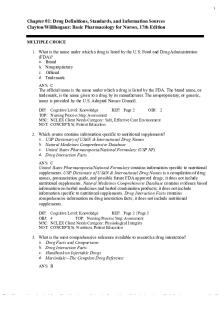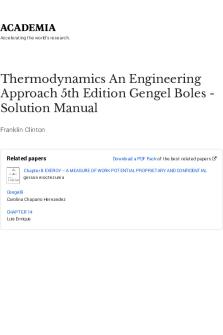Pharmacology for Nurses: A Pathophysiologic Approach (5th Edition) chapter 18 PDF

| Title | Pharmacology for Nurses: A Pathophysiologic Approach (5th Edition) chapter 18 |
|---|---|
| Course | Nursing Pharmacology |
| Institution | Keiser University |
| Pages | 2 |
| File Size | 47.8 KB |
| File Type | |
| Total Downloads | 36 |
| Total Views | 149 |
Summary
Chapter review questions, summary review of chapter with rationale. multiple choice question review of chapter with answer included...
Description
Pharmacology Chapter 18 Review
1. The nurse teaches the patient relaxation techniques and guided imagery as an adjunct to medication for treatment of pain. What is the main rationale for the use of these techniques as an adjunct to analgesic medication? 1They are less costly techniques 2They may allow lower doses of drugs with fewer adverse effects 3They can be used at home 4They do not require self-injection
Answer: 2 Rationale: When used with medication relaxation techniques allows for lower doses of medication to be administered. Pg. 240-241 2. The emergency department nurse is caring for a patient with a migraine headache. Which drug would the nurse anticipate administering to abort the clients migraine attack? 1 Morphine 2 Propranolol (Inderal) 3 Ibuprofen (Motrin) 4 Sumatriptan (Imitrex) Answer: 4 Rationale: Sumatriptan is used to relieve a migrane attack pg. 256
3. A patient admitted with hepatitis B is prescribed hydrocodone with (APAP) acetaminophen (Vicodin) 2 tablets for pain. What is the most appropriate action for the nurse to take? 1 Administer the drug as ordered 2 Administer one tablet only 3 Recheck the order with the health care provider 4 Hold the drug until the health care provider arrives Answer: 3 Rationale: Acetaminophen can be toxic when taken with hydrocodone so the order will need to be rechecked with the doctor. Pg.243-244
4. The nurse administers morphine sulfate 4 mg IV to a patient for treatment of severe pain. Which of the following assessments require immediate nursing interventions? (Select all that apply) 1The patient blood pressure is 110/70 2The patient is drowsy 3The patient's pain is unrelieved in 15 minutes 4The patient’s respiratory rate is 10 breaths per minute 5The patient’s becomes unresponsive Answer: 3,4,5 Rationale: Opioids usually cause opioid depression with the forst dose given so the patient will need to be closely monitored for pain, alertness, and respiratory rate. Pg.245
5. Planning teaching needs for a patient who is to be discharged postoperatively with a prescription for oxycodone with acetaminophen (Percocet) should include which of the following? 1 Refer the patient to a drug treatment center if addiction occurs 2 Encourage increased fluids and fiber in the diet 3 Monitor for GI bleeding 4 Teach the patient to self-assess blood pressure Answer: 2 Rationale: Constipation can occur when taking these medications. An increase in fluid intake can help relieve the constipation. Pg. 249-250
6. What is the most appropriate method to ensure adequate pain relief in the immediate postoperative period from an opioid drug? 1 Give the drug only when the family member reports that the patient is complaining of pain 2 Give the drug every time the patient complains of acute pain 3 Give the drug as consistently as possible for the first 24-48 hours 4 Give the drug only when the nurse observes signs and symptoms of pain
Answer: 3 Rationale: Opioid pain relief should be given consistantly following the postoperative period fo the patient to have adequate pain relief. Pg.243-246...
Similar Free PDFs

Hilton 5th Edition Chapter Fifteen
- 36 Pages

Chapter 2 Homework 5th Edition
- 21 Pages

Dosage Calculations for Nurses
- 8 Pages

Microbiology for Nurses 3053
- 103 Pages

Quiz for chapter 18
- 10 Pages
Popular Institutions
- Tinajero National High School - Annex
- Politeknik Caltex Riau
- Yokohama City University
- SGT University
- University of Al-Qadisiyah
- Divine Word College of Vigan
- Techniek College Rotterdam
- Universidade de Santiago
- Universiti Teknologi MARA Cawangan Johor Kampus Pasir Gudang
- Poltekkes Kemenkes Yogyakarta
- Baguio City National High School
- Colegio san marcos
- preparatoria uno
- Centro de Bachillerato Tecnológico Industrial y de Servicios No. 107
- Dalian Maritime University
- Quang Trung Secondary School
- Colegio Tecnológico en Informática
- Corporación Regional de Educación Superior
- Grupo CEDVA
- Dar Al Uloom University
- Centro de Estudios Preuniversitarios de la Universidad Nacional de Ingeniería
- 上智大学
- Aakash International School, Nuna Majara
- San Felipe Neri Catholic School
- Kang Chiao International School - New Taipei City
- Misamis Occidental National High School
- Institución Educativa Escuela Normal Juan Ladrilleros
- Kolehiyo ng Pantukan
- Batanes State College
- Instituto Continental
- Sekolah Menengah Kejuruan Kesehatan Kaltara (Tarakan)
- Colegio de La Inmaculada Concepcion - Cebu










